 October 2021
Leadbetter Island Easement on Lobster Lake.
When I talk to friends about Maine’s conserved lands, discussions tend to focus on their favorite State Park, their local land trust property, or iconic places like Acadia National Park. Most Mainers don’t realize that roughly half the state’s protected lands exist as conservation easements. These easements enable continued private ownership, with public values such as open space and wildlife habitat secured in perpetuity. Many (but not all) easements also ensure public access.
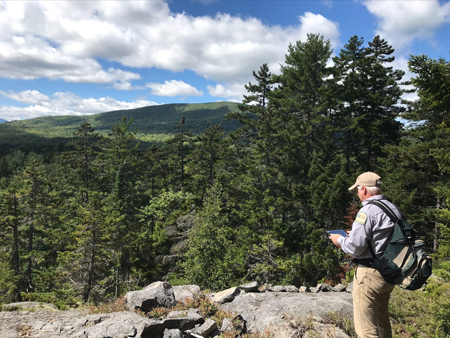
The Bureau of Parks and Lands is directly responsible for monitoring 63 easements that cover 388,000 acres of the state, and BPL staffers Liz Petruska and Joe Anderson (Joe is shown at Pierce Pond Easement) do a remarkable job at visiting these sites, connecting with landowners on management issues, and ensuring the easement terms are honored. (Other easements in Maine are held and/or monitored by our close conservation partners, including The Nature Conservancy, Forest Society of Maine, Maine Coast Heritage Trust, and others). Easements come in all shapes and sizes, ranging from small parcels along the coast to 189,000 acres in the Katahdin Region.
|
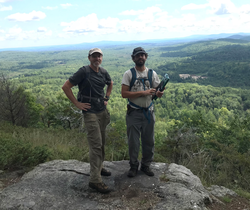
I recently joined Justin Schlawin, ecologist for the Maine Natural Areas Program, and MNAP intern Jack Taylor to visit a 8,600-acre easement in Parsonsfield. (Andy Cutko and Justin Schlawin shown on the Leavitt Plt Easement) We scrambled over some ledges, verified a number rare plant locations, noted the unfortunate presence of invasive Emerald Ash Borer, and mapped uncommon natural communities in relation to blazed boundary lines. In a developing landscape like York County, I was struck once again by the importance of large blocks of undeveloped forestland, and I was thankful for the Forest Legacy Program and Land for Maine’s Future Program for making large scale conservation easements possible.
~ Andy Cutko, Director, Maine Bureau of Parks and Lands
Top of page
|
Archaeological dig in process. All photos courtesy of Leith Smith.
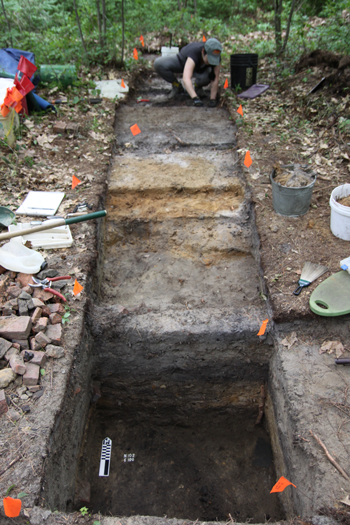
Did you know that a Public Land in Kennebunk was once home to a historic community of African Americans? Documentary research conducted by town historian, Kathy Ostrander Roberts, found the settlement was formed soon after Massachusetts (including Maine) emancipated its slaves in 1783. Close to 20 individuals were present by 1800, but around 1831 the site was abandoned following the death of the last recorded resident known as Old Tom. The Kennebunk Bicentennial Committee wanted to commemorate the community’s presence, but its exact location was unknown. Roberts contacted the Maine Historic Preservation Commission in hopes that archaeology could be used to find the settlement. An archaeological survey permitted by the Bureau of Parks and Lands and funded by the Kennebunk Bicentennial Committee successfully identified the location of two houses. Excavation of one of these in 2018 and 2019 found evidence of at least two structures, indicated by dark stains in the soil where wooden timbers were once located. The houses had small root cellars adjacent to chimney foundations. The appearance and layout of the buildings is yet to be determined.
|
Artifacts at the site included fragments of more than 100 different pottery and glass vessels. Community members possessed and used material goods that were the same as those being used in the Euro-American households in which the former slaves had worked and lived.
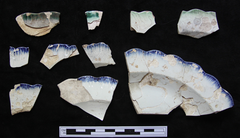
-
Meals were cooked or prepared in cast iron pots, tinware and earthenware.
-
Food was served and/or consumed in a variety of plain and decorated refined ceramic plates, saucers, cups and bowls that were popular at the time.
|
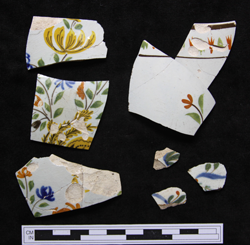
-
Liquids were served in ceramic pitchers and mugs as well as glass cups and stemware (wine glass of today).
-
Tea wares in the form of pots, bowls and saucers were also present, indicating that tea was consumed in the community as it was in the homes of the more privileged classes of greater means.
-
Pipes - The presence of fragmented tobacco pipes shows that smoking, too, was enjoyed.
|
Buttons found during archaeological dig.
-
Clothing - Objects associated with personal adornment are dominated by copper flat buttons used on coats, waistcoats, breeches and hats primarily worn by men.
-
A surprising find was two lead bale seals used to secure new bolts of cloth. Their presence indicates that members for the first time were able to make clothes with cloth of their own choosing to be worn by themselves or to sell.
-
Flint & Shot - The fact that community members owned firearms is indicated by the presence of flint used in flintlock muskets and lead shot and musket balls.
Work is continuing in 2021 on an adjacent site where soil stains indicate the presence another building. An exhibit of the archaeological finds can be viewed at the Brick Store Museum in downtown Kennebunk.
~ J.N. Leith Smith Ph.D., Maine Historic Preservation Commission
Top of page

Fall ushers in the end of boating season and the annual removal of floats at our boat launch sites. Staff will begin removing floats in Northern and Central Maine on October 14th and plan to complete removal of all floats by November 5th.
~ Heather Seiders,
Outdoor Recreation Planner, Boating Division, Maine Bureau of Parks and Lands
|
Cold Stream showing shoreline without boats.
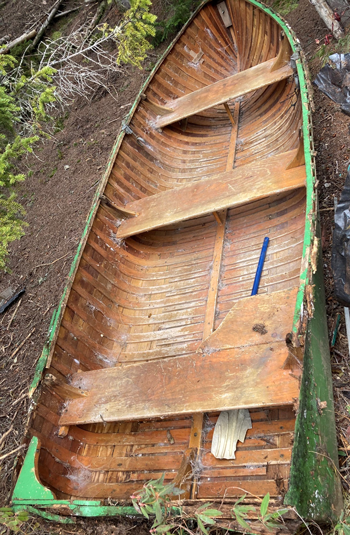
The remote ponds at Cold Stream Public Land have gotten a much needed clean-up. Over the years paddlers have left their canoes on shore ready and waiting for their next visit. Many of these have been forgotten and left to rot. Bureau staff removed obviously unserviceable boats and are asking boat owners to:
- Store boats at least twenty-five feet away from the water. The 25-foot boundary is marked by blue diamonds on trees.
- Label hull with owner name and contact information.
- Practice carry-in, carry-out. Learn more at Leave No Trace Center for Outdoor Ethics.
|
Blue diamond on trees show twenty-five foot boundary behind which boats should be stored.
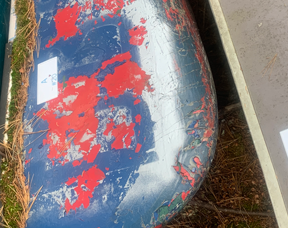
All boats that were found as serviceable are now labelled with a small blue and white numbered sticker to identify them as inventoried by BPL.
Bob Mallard recently visited one boat-cleaned site and commented, "The first boat launch site which historically had the most litter, looked cleaner than I'd ever seen it".... "no longer did it look crowded, and like the boat equivalent of an auto salvage yard"... To learn more about the impact, read Bob's article, Old Boats: An Update in the Northwoods Sporting Journal.
|
Thank you to all the volunteers who helped carry out trash, and to Bureau staff Matt Foust, Public Lands Forester and Bill Beeaker, Public Lands Ranger for taking the lead on this project and their commitment to improving pond shorelines for all visitors.
~ Jocelyn Hubbell, Interpretive Specialist, Maine Bureau of Parks and Lands
Top of page
The Maine Bureau of Parks and Lands (BPL) takes conservation of old forest areas seriously, with nearly 100,000 acres of land managed in Ecological Reserves-- areas where forests are not being managed for timber. Tools employed by the Bureau to retain old forest characteristics include:
- Special Protection Areas such as the Ecological Reserves,
- Legacy tree retention, and
- Long harvest rotations within the 429,000 acres of sustainably managed timberland.
Within a 50 acre stand of trees adjacent to Scopan Lake, just east of Ashland, the Bureau is taking an active approach to enhancing old forest characteristics while harvesting timber.
Scopan Public Land was acquired by the Bureau in the 1970s. Past harvests include spruce-budworm salvage in the 1970s and 1980s and subsequent light selection entries. As a result of BPL management, the stand east of Scopan Lake contains many large hemlock, yellow birch, and sugar maple trees approximately 120 years old. Because eastern hemlock was not harvested in previous entries by the Bureau, due to lack of timber markets, hemlock has increased in relative abundance over time. In its latest harvest, BPL’s goals were to:
- Remove merchantable, higher risk short-lived species including balsam fir, aspen, paper birch and others;
- Reduce eastern hemlock dominance within the stand; and
- Retain and enhance old forest characteristics.
In Maine, old forest is highly limited on the landscape, with less than 1% of Maine’s forest over 150 years old. Some old growth characteristics that are missing from younger forest stands include an abundance of large trees, and high volumes of standing and downed wood. Standing and downed wood provides important habitat for many species including amphibians, cavity nesting birds and mammals, wood boring insects, wood rotting fungi, and others. To retain large live trees, the harvest prescription for the stand at Scopan included retention of large living trees of all species. Standing and downed wood was measured within the stand and compared with data from the Big Reed Forest Reserve—Maine’s largest area of old growth forest—to set targets for standing and downed wood.
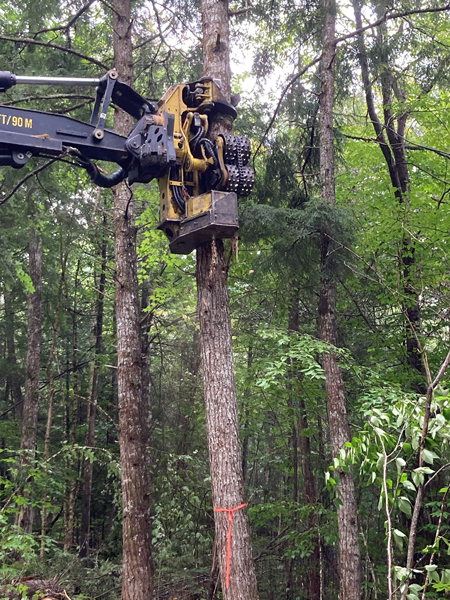
The assessment of standing and downed wood indicated that while the Scopan stand has a moderate volume of downed wood, large standing dead trees were limited in abundance. Based on these findings, 2-4 large hemlocks (>16” diameter) per acre were marked for treatment during harvest operations. These treatments include felling, girdling and high-topping. High-topped trees were cut at a height of 12-20’. All felled materials were placed so they will not be obstacles during future harvests and will continue to provide habitat during all periods of decay.
Old growth cannot be created through harvest operations and is a rare and declining component of Maine’s forest. The harvest at Scopan was a learning experience for the Bureau for assessing and enhancing old growth forest structural characteristics within a managed forest stand, while achieving other silvicultural objectives. Lessons learned from this harvest will help the Bureau add to its tools for old forest conservation and management.
~ Justin Schlawin, Ecologist, Maine Natural Areas Program
Photo: Processor high-topping hemlock tree, courtesy of Steven Allen.
|
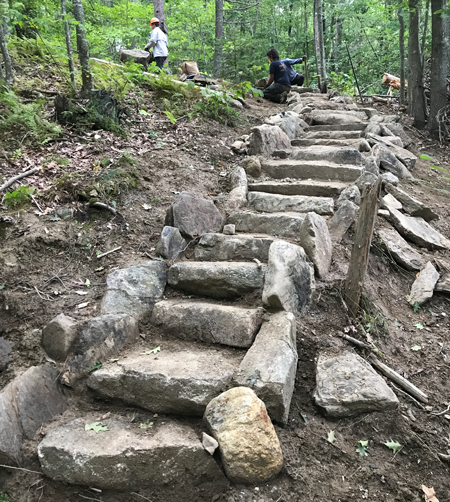 |
Maine Conservation Corps building stone steps at Dodge Point Public Land.
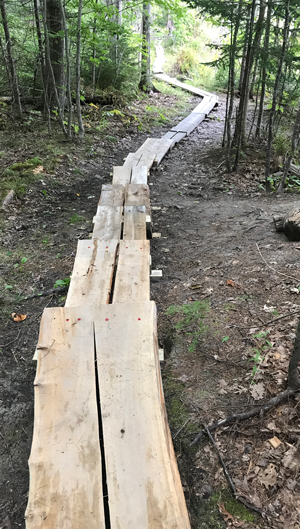
Dodge Point, one of Public Lands most heavily used recreational properties, is receiving some needed trail improvements thanks to the Maine Conservation Corps (MCC) and the Bureau’s stewardship partner, Coastal Rivers Conservation Trust. A five-person MCC crew has been hard at work the last few weeks building stone steps on an eroded portion of the well-used Shore Trail located along the Damariscotta River. This trail provides one of very few access points to tidal waters on Maine's Public Lands (see Cutler Coast for another). Volunteers from Coastal Rivers installed bog bridging and a wooden staircase on the same trail. In a spirit of cooperation Coastal Rivers also provided housing for the MCC crew, a welcome change from their usual tenting accommodations during this time of hurricane remnants and coming cold nights.
~ Stephen Richardson, Senior Forest Engineer, Maine Bureau of Parks and Lands
Top of page
|
The ATV "Jeep Trail" by Big Moose Mountain will be closed for major repairs for the remainder of the season effective Monday, 10-4-21. This means that from Greenville Junction you can ride the North Rd. and South Loop but must then must return the same way. Rockwood and points north can only be accessed from the CC/Shirley Rd. For more information and an updated map, please visit the Moosehead ATV Riders Facebook page. View the Little Moose Public Land section of the Moosehead Lake Shoreline Guide & Map to get an overview of the area.
Sign up for:
-
ATV Trail Alerts by texting DACF ATV to 468311
-
Snowmobile Trail Alerts by texting DACF SNOW to 468311
-
All Bureau Text-to-subscribe options.
Androscoggin Riverlands ablaze in autumn colors. Carol DiBello photo.
- October 2, 2021 : Scales and Tails at Bradbury Mt. State Park
- Plan a Maine Fall Foliage Adventure!
Top of page
Girl Scouts visited State Parks and Historic Sites throughout Maine.
Girl Scouts showed their love of the outdoors and Maine State Parks on September 12 during the annual nationwide Girl Scouts Love State Parks event. While visiting the girls worked on their badges, participated in Junior Ranger activities, and practiced principles of stewardship and Leave No Trace while hiking and exploring the parks.
The girls reported that they really enjoyed getting to hike, picnic, watch birds and wildlife, and see interesting plants. Others said the best part was getting time to relax and play outdoors. Others found time to read and write as well as explore with their families.
We thank the Girl Scouts for visiting, sharing their photos and comments, and for learning about stewardship. Additionally we thank their leaders and families who made sure the girls got to visit, the staff at Girl Scouts of Maine for their on-going collaboration. And lastly, none of this would be possible without the leadership and support at the national level by Girl Scouts USA and the National Association of State Park Directors.
~ Jocelyn Hubbell, Interpretive Specialist, Maine Bureau of Parks and Lands

Nature Love Medicine is perfect for dipping into during this season when nature shares her bounty with us. The collection of essays will help you explore your feelings about nature and perhaps open up a new way of experiencing and appreciating all our earthly kin.
I started by flipping through to one of my favorite writers, Robin Wall Kimmerer, and thoroughly enjoyed Heal-All. From there I thumbed through to those essays that spoke to me within the first few lines before taking in the others over several evenings. There is much to contemplate here. It is a book to come back to time and again.
~ Jocelyn Hubbell, Interpretive Specialist, Maine Bureau of Parks and Lands
Top of page
|
Send article suggestions or newsletter comments to Jocelyn Hubbell, Interpretive Specialist, webmaster, and newsletter editor for the Maine Bureau of Parks and Lands.
|